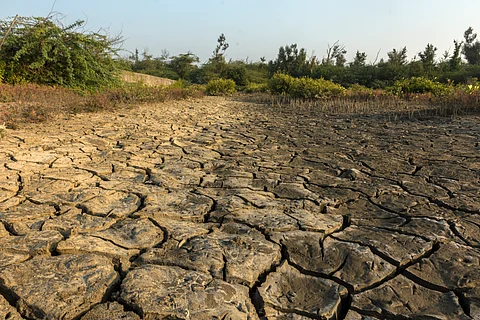

Scientists have raised alarms over the widespread increase in dry areas across the globe, warning that 77.6 per cent of the Earth’s land likely became permanently drier in the three decades leading up to 2020, compared to the previous 30-year period (1961-1990).
In a stark new analysis released on December 9, 2024, United Nations scientists revealed that 4.3 million square kilometres of previously humid landscapes had transitioned into drylands — areas where precipitation is less than 65 per cent of the atmospheric evaporative demand.
This transition has dire implications for agriculture, ecosystems and the livelihoods of those dependent on these regions, as reduced rainfall affects crops, pastures, people and nature.
Such lands now account for 40.6 per cent of the Earth’s total land area (excluding Antarctica). To put this into perspective, this expanse is nearly a third larger than India, the world’s seventh-largest country. Further, if the world fails to curb greenhouse gas emissions, another 3 per cent of the world’s humid areas will become drylands by the end of this century.
These statistics were among the many grim revelations from the landmark report, The Global Threat of Drying Lands, launched at the Conference of Parties (COP16) to the UN Convention to Combat Desertification (UNCCD) in Riyadh, Saudi Arabia. The report aims to quantify both historical and projected future dryland expansions, offering critical insights into their impacts worldwide.
Increasing aridity threatens people and ecosystems in nearly every global region, the report highlighted. The paper is significant because, for the first time, scientists from the UNCCD’s Science-Policy Interface, which works to bridge the gap between science and policy, have clearly documented current and future drying trends and impacts.
Aridity differs from drought in its nature and duration and is considered the world’s largest single driver behind the degradation of agricultural systems. Droughts are short-term anomalies characterised by periods of low rainfall, often linked to high temperatures, low precipitation and reduced air humidity. In contrast, aridity reflects a persistent, long-term lack of available moisture needed to sustain most terrestrial life.
A harsh differentiation is that while droughts also cause massive losses, those end and recovery is possible. But “when an area’s climate becomes drier, however, the ability to return to previous conditions is lost. The drier climates, now affecting vast lands across the globe, will not return to how they were and this change is redefining life on Earth,” Ibrahim Thiaw, UNCCD executive secretary, said.
The report pointed out that much of aridity’s recent rise can be attributed to human-caused climate change and that no region on the planet was projected to transition from historical drylands to future wetlands.
Currently, 2.3 billion people inhabit drylands — a figure that has doubled over the past three decades. In a worst-case climate scenario, this number could rise to five billion by 2100. “These billions of people face even greater threats to their lives and livelihoods from climate-related increases in aridification and desertification,” the report warned.
Asia is home to 1.35 billion dryland inhabitants, more than half the global total. China, India and Pakistan together account for about 50 per cent of the global dryland population. Meanwhile, nearly half of Africa’s population (620 million people) also lives in these arid regions.
Rising aridity has already taken a toll on economies. Between 1990 and 2015, African nations recorded a 12 per cent decline in gross domestic product (GDP) due to aridity.
Among Asian nations, aridification — which has a greater impact than precipitation or temperature alone — was considered responsible for a 2.7 per cent GDP drop over the same period.
While few climate-model projections directly linked future aridity to poverty, climate drying was expected to exacerbate poverty, resulting in GDP growth losses of approximately 16 per cent and 6.7 per cent in Africa and Asia, respectively, according to the analysis.
Increasing aridity was expected to play a role in larger and more intense wildfires in the climate-altered future, with a 74 per cent expected increase in wildfire-burned areas in California and 40 per cent additional annual high fire danger days in Greece by 2100 compared to late 20th century levels.
At least 55 per cent species (mammals, reptiles, fish, amphibians, and birds) were at risk of habitat loss from aridity in hotspots like arid regions in west Africa, western Australia, Iberian Peninsula and humid regions of southern Mexico and northern Amazon rainforest.
In parts of the world where future aridity increases are expected to worsen desertification, sand and dust storms are expected to become more common and harmful as well.
Sand and dust storms have been strongly linked to aridity (or prolonged drought conditions), along with other factors that contribute to desertification and the loss of vegetation cover, such as unsustainable land use.
Calling aridity a global, existential peril, the report also highlighted how previously it was shrouded by a “fog of scientific uncertainty,” as for years, rigorously documenting aridity’s rise was challenging and controversial.
“Its long-term nature and the complexity of aridity-determining processes — rainfall, evaporation and plant transpiration, among others — led to conflicting results and an abundance of scientific caution,’ it said.
The report will be critical for nations to track aridity’s changes and develop policies and approaches for slowing its climb, reducing its impacts and adapting to a perennially drier landscape.